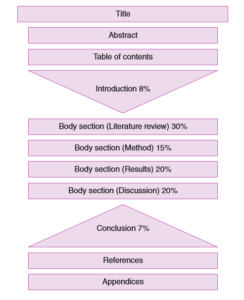At a glance, a typical dissertation includes the following chapters:
-
- Title Page
- Acknowledgements
- Abstract
- Table of Contents
- List of Figures & Tables
- List of Abbreviations
- Glossary
- Introduction
- Literature Review
- Methodology
- Findings/Results
- Discussion
- Conclusion
- Reference List
- Appendices
The final dissertation structure may vary according to your study level, degree, university requirements, or citation styles, such as APA, Harvard, and MLA.
Why is dissertation structure important?
As activist Abbie Hoffman once said:
“Structure is more important than content in the transmission of information.”
Structure guides your reader, showcases your logic, and presents your research clearly and professionally.
How To Structure A Dissertation Or Thesis
Dissertation structures vary depending on:
- Your research approach (qualitative vs. quantitative)
- Research design (exploratory, descriptive, etc.)
- Discipline (humanities, sciences, engineering, etc.)
- University-specific guidelines
Tip
Always refer to your department’s handbook and consult your supervisor for any formatting or structural specifics
Core Components Of A Dissertation
Here are the main sections of a dissertation or a thesis.
1. Title Page
Your dissertation will start with a title page that will contain details of the author/researcher, research topic, degree program (the paper is to be submitted for), and research supervisor. In other words, a title page is the opening page containing your name and dissertation topic.
The name of your university, logo, student ID, and submission date can also be presented on the title page. Many academic programs have stringent rules for formatting the dissertation title page.
2. Acknowledgements
The acknowledgements section allows you to thank those who helped you with your dissertation project. You might want to mention the names of your academic supervisor, family members, friends, God, and participants of your study, whose contribution and support enabled you to complete your work.
However, the acknowledgements section is usually optional.
3. Abstract
Perhaps the smallest yet most important part of a thesis, an abstract contains 5 parts:
- A brief introduction of your research topic.
- The significance of your research.
- A line or two about the methodology that was used.
- The results and what they mean (briefly); their interpretation(s).
- And lastly, a conclusive comment regarding the results’ interpretation(s) as a conclusion.
4. Table of Contents
The table of contents is the section of a dissertation that guides each section of the dissertation paper’s contents. Depending on the level of detail in a table of contents, the most useful headings are listed to provide the reader with the page number on which said information may be found.
A table of contents can be inserted automatically as well as manually using the Microsoft Word Table of Contents feature.
5. List of Figures and Tables
If your dissertation paper uses several illustrations, tables and figures, you might want to present them in a numbered list in a separate section. Again, this list of tables and figures can be auto-created and auto-inserted using the Microsoft Word built-in feature.
6. List of Abbreviations
Dissertations that include many abbreviations can also have an independent and separate alphabetised list of abbreviations, so readers can easily figure out their meanings.
7. Glossary
If you think you have used terms and phrases in your dissertation that readers might not be familiar with, you can create a glossary that lists important phrases and terms with their meanings explained.
Looking for dissertation help?
Research Prospect to the rescue then!
We have expert writers on our team who are skilled at helping students with dissertations across a variety of disciplines. Guaranteeing 100% satisfaction!
Chapters Of A Dissertation
Once you have your component checklist, here are the main chapters that are a part of a dissertation or a thesis.
8. Introduction
The introduction sets the stage for your dissertation. It presents the research aim and key objectives and provides the context for your study. Key elements include:
- Background information to introduce the research context.
- A clear definition of the research problem.
- Justification of why your study matters and its contribution to existing knowledge.
- A brief outline of the structure of the dissertation.
- A dedicated theoretical framework subsection explaining the core theories underpinning your research.
The introduction should be engaging, relevant, and clear, addressing the what, why, when, and how of your study.
9. Literature Review
The literature review presents relevant past research and demonstrates your understanding of existing literature. It complements your primary research and includes:
- Use of authentic and current academic sources (books, journals, papers).
- Analytical evaluation of sources, highlighting strengths, limitations, methodologies, and findings.
- Identification of gaps, contradictions, and key themes.
- A coherent structure that builds a case for your research.
Literature review checklist
- How does your research work fill a certain gap in existing literature?
- Did you adopt/adapt a new research approach to investigate the topic?
- Does your research solve an unresolved problem?
- Is your research dealing with some groundbreaking topic or theory that others might have overlooked?
- Is your research taking forward an existing theoretical discussion?
- Does your research strengthen and build on current knowledge within your area of study?
In quantitative studies, relationships between variables (e.g., A is positively correlated with B) may also be discussed.
10. Research Methodology
This chapter explains the research methods and tools used to collect and analyse your data. Common primary data collection methods include:
- Questionnaires
- Interviews
- Surveys
- Focus Groups
- Observations
Your methodology should describe:
- The research type (qualitative, quantitative, or experimental).
- Data collection techniques and the context of your study (how, when, where).
- Data analysis strategies (e.g., regression analysis).
- Software/tools used (SPSS, Excel, STATA, etc.).
- Limitations (if required by your institution).
- A justification for your chosen approach and methodology.
11. Research Findings
This section presents the results of your research, aligned with the research questions.
- Focus on findings directly related to your research objectives.
- Supplementary data can be added to the appendices.
- Depending on your field and institutional guidelines, the findings may be combined with the discussion chapter.
- For quantitative data, findings are often separated from the discussion. For qualitative data, both may be presented together.
Tip
Use graphs, charts, tables, and visuals to improve clarity, and provide brief explanations without repeating what the visuals already show.
12. Discussion
The discussion chapter is where you interpret and evaluate your findings. It should tie your results back to your research questions and theories.
Dissertation discussion checklist
- Did your work answer all the research questions or test the hypothesis?
- Did you come up with some unexpected results for which you have to provide an additional explanation or justification?
- Are there any limitations that could have influenced your research findings?
This chapter is your opportunity to develop arguments, highlight key themes, and show the impact of your findings.
13. Conclusion
The conclusion summarises your study by revisiting the research questions and objectives. It includes:
- Key findings in response to each objective.
- Reflection on the study’s contributions to existing knowledge.
- (Optional) Recommendations if required by your institution.
Tip
Always link your conclusion back to the aims outlined in the introduction.
14. Reference List
All in-text citations must be included in a reference list (or bibliography if you have cited additional background materials). Popular referencing styles include:
15. Footnotes
Each style has specific formatting rules, so follow your institution’s guidelines carefully.
16. Appendices
The Appendices section contains supporting material that is too detailed for the main chapters but still relevant, such as:
- Interview transcripts
- Survey instruments
- Supplementary readings
- Raw data or extended tables
An Outline of Dissertation/ Thesis Structure
The above image has been taken from Hopkins, D. and Reid, T., 2018. The Academic Skills Handbook: Your Guide to Success in Writing, Thinking and Communicating at University. Sage.
Frequently Asked Questions
The title page will contain details of the author/researcher, research topic, degree program (the paper is to be submitted for), and research supervisor’s name(s). The name of your university, logo, student number, and submission date can also be presented on the title page.
The acknowledgements section allows you to thank those who helped you with your dissertation project. You might want to mention the names of your academic supervisor, family members, friends, God, and participants of your study whose contribution and support enabled you to complete your work.
Yes, but only if you think that your paper does not contain any terms or phrases that the reader might not understand. If you think you have used them in the paper, you must create a glossary that lists important phrases and terms with their meanings explained.
Any information that is not directly relevant to research questions or hypotheses but could be useful for the readers can be placed under the Appendices, such as the questionnaire that was used in the study.
You can use any of the referencing styles, such as APA, MLA, and Harvard, according to the recommendation of your university; however, almost all UK institutions prefer the Harvard referencing style.
It depends on the level of study:
- Undergraduate: 8,000-12,000 words
- Master’s: 15,000-25,000 words
- PhD: 50,000+ words
Yes, especially in qualitative dissertations. Always check your department’s guidelines.
Not all. It’s more common in social sciences and humanities.
Usually, no. But confirm with your institution.
- References: Only what you cite in your text.
- Bibliography: Everything you read (cited or not).







